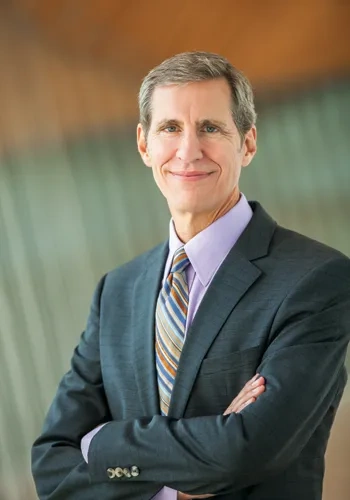Art For the People
Don Bacigalupi took on one of the biggest gambles the art world has ever seen—and made it look easy.

Striding the halls of the Crystal Bridges Museum of American Art on a crisp Arkansas afternoon, Don Bacigalupi walks so fast that a visitor can hardly keep up. “Now, this is an incredible piece,” he says more than once, pausing for an instant to marvel at a painting or sculpture before rushing to the next.
Tall, lanky, and in an impeccably tailored suit, Bacigalupi, MA ’85, PhD ’93, has something of the small-town mayor about him. He greets every museum docent and employee he passes with a cheerful hello, then ducks into a banquet hall where caterers are setting up for a dinner. Secretary of State Hillary Clinton and a cohort of ambassadors will be the evening’s guests of honor; Bacigalupi nods approvingly at the white tablecloths and floral arrangements. He knows everyone and every detail in the museum—it’s become a second home.
Which is remarkable considering that in 2009, when a recruiter told Bacigalupi about a museum director opening in Northwest Arkansas, he immediately turned it down. “I think I gulped,” he remembers, “and I said, ‘No thanks, because I’m not moving to Arkansas.’”
Still, he was intrigued by the improbable project—a world-class art museum to be built in rural Bentonville—and so he met with its mastermind, Wal-Mart heiress Alice Walton. As director of the Toledo Museum of Art in Ohio, itself an elite collection in a region not known for art, Bacigalupi relished finding ways to make art compelling to anyone. He made clear that he wasn’t applying for the job, just feeding his curiosity.
But after a long talk with Walton, he was converted. Walton, he realized, shared his love of bringing high art to working-class people. “There was a resonance,” Bacigalupi says. “My career has been about building communities around museums and making art relevant. The idea of doing that in Bentonville was thrilling.”

It was also a risky choice. In 2005, when Walton announced that she was planning to open the biggest new museum of American art in more than 50 years in her native Bentonville, the art world met the news with equal parts snobbery and skepticism. Art magazine Glasstire summed the chatter up: “[Crystal Bridges is] in Arkansas, it’s got a name that people widely agree sounds like a meth rehab facility, and it’s funded with Wal-Mart’s filthy lucre.”
Wal-Mart has indeed made Alice Walton, daughter of Wal-Mart founder Sam Walton, incomprehensibly rich: by some accounts, her family owns more wealth than the bottom 40 percent of all Americans. And when she started buying masterworks like Asher Brown Durand’s “Kindred Spirits” (for a cool $35 million), some critics saw her as a robber baroness. The New York Times went so far as to bemoan Walton’s Durand purchase as a kidnapping. Bacigalupi disagrees: “Thousands more people, and people who didn’t previously have access to art, see ‘Kindred Spirits’ here [at Crystal Bridges] than when it was in New York.”
[pullquote]“The belief that art belongs to the coasts has got to go." [/pullquote]“The belief that art belongs to the coasts has got to go,” says UT art history professor John Clarke, who was Bacigalupi’s graduate advisor. “Everybody deserves great art, and I think Crystal Bridges’ success demonstrates that very powerfully.”
And so it has. Despite all the naysayers and obstacles—including an audacious architectural design in which the galleries appear to float on water from a nearby spring—Crystal Bridges has been an enormous hit since its doors opened in 2011. The museum’s first year drew more than 600,000 visitors from all 50 states and dozens of countries, and their impact is reshaping the area. In Bentonville’s town square, a diner sells Freedom Fries next to a new coffee shop packed with tourists and locals sipping lattes.
Behind the scenes, of course, the rise of Crystal Bridges was far from a sure thing. Clarke attributes much of its success to Bacigalupi’s singular leadership. “It’s all about having the right personnel,” he says, “and Don hired really good curators and museum staff. He has a real talent for not just the art side of things, but also for being a people person.”
Bacigalupi says he’s proud of how quickly Crystal Bridges has taken off, noting that it’s already one of the most-visited art museums in the nation. “There were times when it was so challenging that nobody thought we were going to succeed,” he says. “But we’ve changed the focus on American art, not just regionally but nationally. The museum speaks for itself.”
Top: Entrance to the [Crystal Bridges] gallery bridge exhibiting early 20th-century art.
Left: Don Bacigalupi. Portrait by Timothy Hursley; both photos courtesy Crystal Bridges Museum of American Art.





